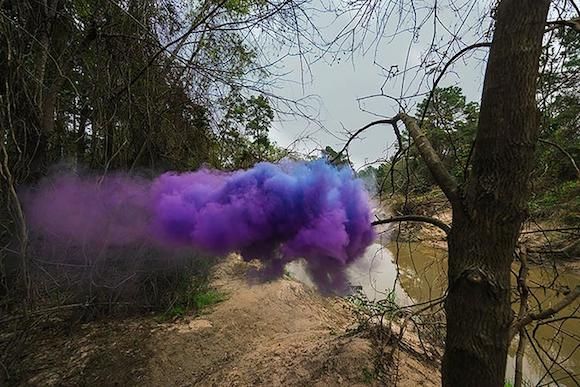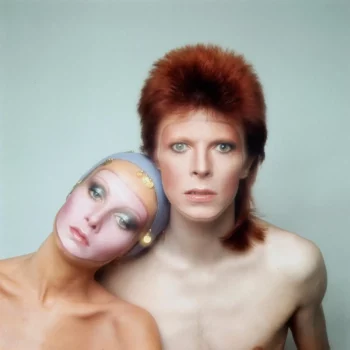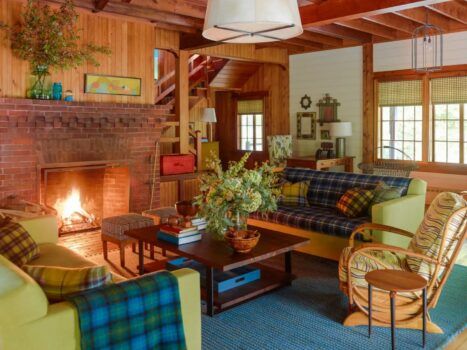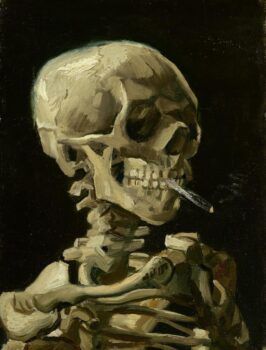Whether it’s a shot of a burned-out building littered with disintegrating drywall or a wide-open prairie dotted with scrub brush, the photographs in Irby Pace’s “Explosions in the Sky” series are haunting testaments to the power of magical realism in the visual arts. All due to lingering clouds of smoke. Indeed, brightly colored plumes imbue the artist’s work with a sense of postapocalyptic beauty that subtly suggests human inhabitants but ones who have recently (and mysteriously) departed. The viewer is left to wonder, What happened to this world? And how does he do that?
It’s a tension between technical skill and creative play that drives the Texas-based artist to continue with “Explosions in the Sky,” the longest-running series of his artistic career. “The question of ‘how do I even make this happen?’ attracted me to the project initially,” Pace says. Five years on, his goals have evolved: “How do I make this better? More fluid? Is this still interesting?”
The answer to the last question is a resounding yes, and his current solo show, “Temporary Forms of Continuity in Spaces,” up through August 27 at Galleri Urbane in Dallas, further proves that Pace’s photos have a lot of life left to give.
Below, the photographer provides fascinating insights into his work, although a magician will never fully reveal his secrets.
How do you go about making your “Explosions in the Sky”?
I’ve been working on the project informally since grad school but wasn’t able to perfect it at the time because I was always working on six projects simultaneously. Once I formally started pursuing the project in 2012, I tried so many things to get it right and definitely overcomplicated it at first — my nature is to always go to the most complex method first. But, basically, I make the smoke bombs and once I set them off, I have anywhere from between 30 seconds and two minutes to shoot. Often, I’ll shoot the same location with five or six colors just to see what happens and decide which one works later.
I don’t like getting too technical in talking about my process since it’s taken me so many years to get it right. I’ll often have a magazine call me and ask me to tell them how I do it because they’ve got a photoshoot with a celebrity. I say I’d come out and do it for them, but no one has ever taken me up on that.
Are there certain times of day, weather patterns or colors that work better or worse than others?
The weather definitely plays a big role in the photographs. Rain and humidity help, since the air is denser and the smoke stays together better. Too much wind will take the smoke away before I get a chance to photograph it. As for colors, blues are the hardest to work with — there’s something about the chemical make-up that make them dissipate more quickly than other colors.
How do you choose the locations for your photographs?
I’m always scouting for new places to shoot. If I find a spot, I’ll drop a pin in Google Maps to remind myself to go back. Other times, I’ll go intentionally roam for a new spot. I always have my equipment with me in my car so I can mix on location. And I’ll revisit the same spot at different times of day — early morning, midday and evening — to see what kind of magic is happening there. Nature lets me know the best time to shoot.
Is there a specific photograph that was particularly difficult to get right?
Meteor took a couple of weeks of night-shooting to get right. I’d never done night-shooting before, and it was definitely the most challenging piece, although it’s also the one that’s recently made me feel the most rejuvenated in the work. It was just more fun. I believe failures inform future work, and since so much of this series is about working through a new process, it helped me push my work forward.
How does the Texas landscape inform your work?
It’s funny because I went to Brooklyn awhile back to shoot and found myself searching for spots that reminded me of all the Southern spaces I’m used to shooting. There’s just something about the emptiness and blankness of the Texas landscape that I’m drawn to. I like the negative, in-between spaces that are often ignored, whether they’re industrial or natural. I grew up in Texas, and there are so many areas where you can not see a single thing for miles. You feel like you could do anything out here.
How do you see this series evolving over time?
The cloud is my form, and I’m looking at different, more artistic ways to challenge myself with it, even if it’s just trying to use white smoke to create the same effect. Since I feel like there’s a childlike influence in most of my work, I’m currently making view master slides based on stereoscope cards from the 1900s, as well as 3-D versions of some of my prints that will have an animated quality to them. I’m also interested in using video and sculpture, making 3-D representations of the clouds to hang in galleries.












